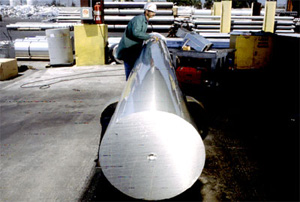Almex’s specially designed ULTREX™ Testing Methods for casting and quality inspection of the cast and machined billet or slab fall in the following two categories:
ULTREX™ I – High Temperature “On-line” Testing Equipment
Inspection of billet and slab for detection of cracks while casting is in progress. This is a “hot” inspection method which uses a high temperature couplant media. The operating principle of the equipment is the “pulse-echo” ultrasonic technique which can detect major inconsistencies in the cast product (post wiper emergence) such as cracks and sub-surface quality issues including centerline cracks.
Instantaneous detection of cracks assists in controlling cast house costs. If a crack is detected, depending on its location and spread, a corrective action can be immediately implemented to arrest the growth of the crack or a decision can be taken to abort the drop all together; thus saving substantial remelt costs and down-stream handling. With 2XXX and 7XXX alloys, early detection of cracks can also greatly enhance the safety of the cast house.
An optional bar code writer is available with the system which will automatically print and apply a detailed bar code to the inspected billet per customer specifications before the inspected billet is discharged from the inspection table. This system also provides both automatic marking of defective billets and the specific location of the identified defect. The defective billets are also indented with red ink spray at the top / bottom end face for easy recognition.
ULTREX II™ – Room Temperature “Off-Line” Ultrasonic Inspection Equipment
The Ultrex II™ “non-submerge” ultrasonic instrumentation was developed by Almex for inspection of scalped slabs and machined billets. The system detects internal defects of an extremely fine size. It is based on the “pulse-echo” principle but uses a large probe, approximately 25 mm diameter, and works at the 2.25 Megahertz frequency. It is well known that a defect in the cast product of the size of 75 microns (0.003”) is “large” enough to cause the rejection of finished forging, extrusion or rolled plate since the original defect undergoes substantial enlargement in size during the subsequent thermo-mechanical working of the material. Accordingly, Almex’s Ultrex II™ ultrasonic testing equipment and procedures are designed to inspect such “small” sizes of discontinuities.
Typically in 2XXX and 7XXX series aluminum alloys, these discontinuity indications on the ultrasonic testing screen provide a reflection of the following types of defects:
-
Agglomerated gas porosity
-
Non-metallic inclusions
-
Metallic inclusions (such as early precipitates of Ti-B-Zr and Chromium)
-
Salt particles
-
Very large primary phase segregation
-
Incipient melting during homogenization
-
Insufficient homogenization;
